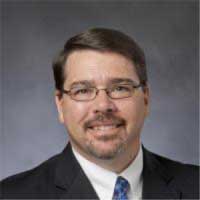NP Advocates to Know: Dr. Michael Zychowicz on Veterans’ Care
Nursing Colleges Search
When you click on a sponsoring school or program, or fill out a form to request information from a sponsoring school, we may earn a commission. View our advertising disclosure for more details.
“Today’s veterans have willingly put their lives on the line to defend our country and our allies abroad. For the sacrifices they make in service of us, the least we can do is care for the wounds they obtain, both physical and mental.”
Michael E. Zychowicz, DNP, Clinical Professor, Duke University School of Nursing
Advocacy is woven deeply into the nurse practitioner (NP) role. It’s a part of the job that’s never finished. Advocacy can occur at a micro level, by advocating one-on-one for a particular patient, or at the macro level, by lobbying for policy changes; it’s often a mix of the two.
For many NPs, advocacy is about a particular issue close to their heart, one connected to underserved patients who deserve additional support. For Michael Zychowicz, DNP, the issue is veterans’ care.
There are over 19 million veterans in the United States (Pew 2021). Their health needs are largely met by the US Department of Veterans Affairs (VA), which houses the largest integrated healthcare system in the country. Its motto is a quote by Abraham Lincoln: “To care for him who shall have borne the battle, and for his widow, and his orphan.” Yet when it comes to completing that mission, challenges remain around awareness, access, and understanding.
Today’s nurses and nurse practitioners (NPs) are important in caring for our nation’s veterans. But more can be done to serve those who have served. Read on to learn about the state of veterans’ care today and where it’s going.
Meet the Expert: Michael Zychowicz, DNP, ANP, ONP, FAAN, FAANP

Dr. Michael E. Zychowicz is a clinical professor of nursing at Duke University School of Nursing (DUSON). He is also co-director for the Duke-Durham VA postgraduate primary care NP residency, and leads the veterans’ health specialty and the orthopedic NP specialty program that was developed with funding from the Health Resources and Services Administration (HRSA). Dr. Zychowicz served as an army reserve officer in the Army Nurse Corps between 1991 and 2005.
Dr. Zychowicz is the editor of the books Orthopedic Nursing Secrets and Introduction to Orthopedic Nursing, and has published several journal articles and book chapters on various orthopedic topics. He received the American Association of Nurse Practitioners (AANP) Award for Excellence in 2007 and was also selected for the Outstanding Orthopedic Nurse Award by the National Association of Orthopedic Nurses (NAON).
The State of Veterans’ Care Today
Veterans have significantly different healthcare needs from the general population. It’s not just that combat veterans tend to have complex medical conditions. Even non-combat veterans experience a wide range of dangerous circumstances while performing their military service: they may suffer from chemical exposure, radioactive exposure, tropical diseases, and serious occupational injuries. The training itself is highly strenuous.
“Most people know on an intellectual level that military training is hard,” Dr. Zychowicz says. “But unless someone’s walked ten miles in crappy boots with an 80-pound backpack on two hours’ sleep, it’s hard to understand the sheer physicality. It takes a large toll on the body.”
Compared to those who haven’t served in the military, veterans are far more likely to have musculoskeletal problems, whether it’s arthritis or chronic pain, having dealt with fractures or gunshot wounds, or losing limbs. And many veterans suffer from multiple conditions, both physical and mental.
“The uniqueness of the nurse and the nurse practitioner in veterans’ healthcare is that our training and education comes with a holistic care approach,” Dr. Zychowicz says. “It enhances our ability to deliver care to veterans, and see them as a whole instead of just a disease.”
How the VA Serves Veterans
The majority of veterans’ care runs through the VA, which employs more than 371,000 healthcare professionals and support staff. The VA is also the nation’s largest provider of graduate medical education, partnering with medical schools, nursing schools, and teaching hospitals to have students and residents complete clinical rotations in caring for veterans as part of their training.
“Everyone I’ve interacted with inside the VA, from clinicians to non-clinicians, has been laser-focused on improving healthcare for veterans,” Dr. Zychowicz says. “The clinical care is phenomenal, and the dedication is palpable.”
Duke University, where Dr. Zychowicz works, is the academic partner of the Durham VA. Together, they’ve developed a one-year residency program for educating NPs in caring for veterans. It’s a natural fit.
“Something unique about VA care is that it uses a highly interprofessional care delivery model,” Dr. Zychowicz says. “Physicians and NPs and PAs and nurses and everybody else in the healthcare team practices to the highest level of their ability to practice, and all members on the team are highly valued in their role and their input and their ability to take care of the veterans.”
Challenges in Veterans’ Care
The VA is an ambitious healthcare system, but it’s not a perfect one. Veterans themselves give the agency mixed ratings (Pew 2019). Geographic constraints mean that many veterans in rural areas have no easy access to care. Even in more accessible areas, wait times in specialty care have become a significant challenge (GAO 2023). And many veterans opt out of mental health services, even when they’re available—a serious concern in a demographic with an abnormally high suicide rate.
“With veterans, there’s an increased stigma around showing weakness,” Dr. Zychowicz says. “It’s a warrior attitude: you have to be tough. That’s difficult to get around, but there are robust mental health services within the VA.”
Healthcare providers, too, can improve their understanding of veteran care. Nursing schools don’t do enough to ingrain the nuances of veteran care in their curriculum. And while many physicians, nurses, and NPs move through VA facilities as a training space, they may only complete 80 to 100 hours in such a setting; some may not do any veteran care training at all.
“I’m not sure most clinicians are as adequately prepared to take care of the veteran population as they could or should be,” Dr. Zychowicz says. “Schools of nursing broadly should have additional curricula content that teaches students about the unique needs of this vulnerable population: our veterans.”
The Future of Veterans’ Care
Veterans’ care is changing at the speed of technology. Telehealth is helping to address access issues. The VA is embracing 3D printing and virtual reality for both patient care and provider training. And initiatives like the Innovation Ecosystem, the National Center for Collaborative Health Innovation (NCCHI), and the Office of Healthcare Innovation and Learning (OHIL) bring together champions from the VA, academia, and the public and private sectors to drive further advancement in healthcare services at the VA.
“The VA is a highly innovative organization,” Dr. Zychowicz says. “Whether it’s technology for surgery, distance-based healthcare, or developing partnerships with private industry, I see the VA as leading the way for a new future of healthcare delivery.”
The future of veterans’ care will continue to evolve as veterans themselves change, too. The demographic profile of veterans is becoming more racially and ethnically diverse; more women veterans are expected, too. Since 2016, Gulf War veterans have made up the largest share of all US veterans, and this represents a fundamental shift: these are voluntary service members, not conscripted soldiers. Their health now rests in the hands of another willing force.
“There are many reasons why veterans’ care is important,” Dr. Zychowicz says. “Our veterans put their lives on the line to defend our country and our allies abroad. For the sacrifices they make in service of us, the least we can do is care for the wounds they obtain, both physical and mental.”
Resources for NPs Interested in Veterans’ Care
To learn more about veterans’ care, and how to get involved, check out some of the resources below.
- Disabled American Veterans (DAV): DAV provides free, professional assistance to more than 1 million veterans annually, connecting them with the healthcare, disability, employment, education, and financial benefits they have earned through military service. Over the past 100 years, DAV has submitted more than 12 million claims on behalf of veterans.
- US Department of Veterans Affairs (VA): The VA is the US government agency that provides lifelong healthcare services to eligible military veterans. It is the largest integrated health system in the nation, with 1,255 facilities serving 9 million enrolled veterans each year.
- Veterans of Foreign Wars (VFW): Established in 1899, VFW is an organization of US war veterans that seeks to speed the rehabilitation of disabled and needy veterans, and to assist widows and orphans, and dependents of veterans. VFW offers direct intervention on behalf of veterans experiencing problems accessing care through the VA.
- Wounded Warrior Project (WWP): Founded in 2003, WWP is a nonprofit organization that offers programs, services, and events for veterans of military actions following September 11, 2001. Their programs in mental health, career counseling, and long-term rehabilitative care aim to improve the lives of millions of veterans and their families.

